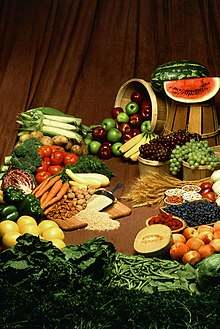Healthy eating habits/Healthy Eating for Young Adults Studying or Working Full-time

This page is aimed at educating young adults aged 18-30 years old who are studying or working full-time about eating a balanced diet and making quick and healthy food choices. Recommendations for Australian adults can be viewed on the Australian Guidelines to Healthy Eating 2013 page and are discussed below.
Why is eating a healthy balanced diet important?[1][2][edit | edit source]
- Helps maintain or reach healthy weight
- Eating a regular balanced diet can help limit the amount of energy dense foods consumed
- Unplanned/irregular eating habits are more likely to increase poor food choices and may lead to higher consumption of fat, sugar and salt.
- Helps increase the consumption of essential vitamins and minerals needed for the body to function
- Helps prevent risks associated with diet related diseases
- E.g. Obesity, CVD, Type 2 Diabetes
Food Group Guidelines[3][edit | edit source]
| Vegetables | Fruit | Grain Foods | Meat and Alternatives | Dairy Foods | |
|---|---|---|---|---|---|
| Males | 6 | 2 | 6 | 3 | 2 1/2 |
| Females | 5 | 2 | 6 | 3 1/2 | 2 1/2 |
| Examples of on serve |
|
|
|
|
|
Choosing Healthier Food Products Quickly[edit | edit source]
There are so many products in supermarkets that claim to be healthier than others. It is difficult to distinguish which are really healthier options out there with so many claims. As there are many different options and claims out there it can become overwhelming to actually know which product is really best. Learning how to read nutritional labels may help.
Reading Nutritional Labels[4][edit | edit source]
Reading nutrition labels can be a little daunting if you do not know where to start, however with these simple and easy steps you can start choosing healthier food choices in no time.
- As many food products have different serving sizes, it is best to compare products using the 100 g column of the nutritional panel – this helps avoid doing unnecessary calculations.
- It is important to avoid high-sugar products. Look for products containing less than 15 g of sugar per 100 g.
- Many products can contain large amounts of salt, even those you may not suspect. Products considered to have a low amount of salt are those with less than 120 mg of sodium per 100 g, and medium salt containing products are 120–400 mg per 100 g. High salt containing foods are those with more than 400 mg per 100 g, and it is important to avoid these.
- Choose food products with less than 10 g of total fat per 100 g and less than 3 g of saturated fat per 100 g.
- The ingredients are listed from highest content to lowest. Check the first three items in the ingredients list (try to avoid products that list sugar in the first three items).
Using a Mobile Application[edit | edit source]
If you don’t have time to read nutritional panels, then don’t fret, a mobile application, called FoodSwitch, was designed to help individuals choose healthier options quickly and easily using your mobile. For more information visit the FoodSwitch website.

Healthy Quick Tips[2][3][edit | edit source]
- Plan your meals ahead of time
- Choose a wide variety of vegetables in a range of colours
- Choose low fat dairy options
- Choose low GI carbohydrate options (e.g. multi-grain bread rather than white or wholemeal bread)
- Have plenty of water instead of soft drinks and juices
- Choose steamed/grilled food options when eating out
- Limit salt added at cooking and at the table
- Don’t skip breakfast
- Eat regularly
- Try having discretionary foods only sometimes and in small amounts (e.g. pies, ice cream, processed meats, chips, burgers etc)
References[edit | edit source]
- ↑ Brown, J. E. et al. (2011). Nutrition through the life cycle (4th Edition). Belmont, CA, Wadsworth, CENGAGE Learning.
- ↑ a b National Health and Medical Research Council (n.d.). Tips for eating well. Retrieved from: http://www.eatforhealth.gov.au/eating-well/tips-eating-well
- ↑ a b National Health and Medical Research Council (2013). Healthy eating for adults. Retrieved from: http://www.nhmrc.gov.au/_files_nhmrc/file/publications/n55g_adult_brochure_print.pdf
- ↑ National Health and Medical Council (n.d.). How to understand food labels. Retireved from: https://www.eatforhealth.gov.au/sites/default/files/files/eatingwell/efh_food_label_example_130621.pdf